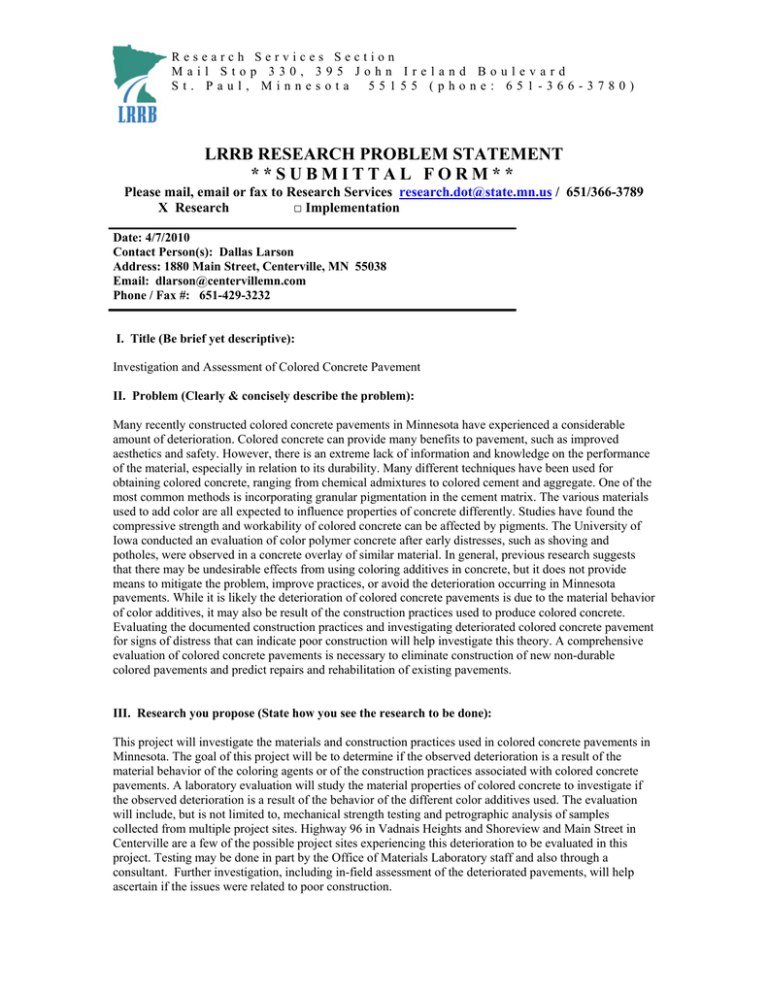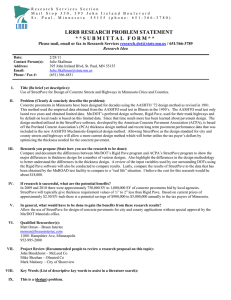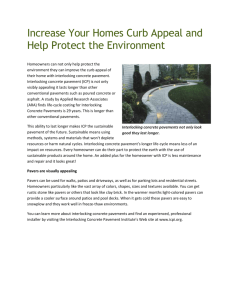R e s e a r c h ... M a i l S t o p ...
advertisement

Research Services Section Mail Stop 330, 395 John Ireland Boulevard St. Paul, Minnesota 55155 (phone: 651-366-3780) LRRB RESEARCH PROBLEM STATEMENT **SUBMITTAL FORM** Please mail, email or fax to Research Services research.dot@state.mn.us / 651/366-3789 X Research □ Implementation Date: 4/7/2010 Contact Person(s): Dallas Larson Address: 1880 Main Street, Centerville, MN 55038 Email: dlarson@centervillemn.com Phone / Fax #: 651-429-3232 I. Title (Be brief yet descriptive): Investigation and Assessment of Colored Concrete Pavement II. Problem (Clearly & concisely describe the problem): Many recently constructed colored concrete pavements in Minnesota have experienced a considerable amount of deterioration. Colored concrete can provide many benefits to pavement, such as improved aesthetics and safety. However, there is an extreme lack of information and knowledge on the performance of the material, especially in relation to its durability. Many different techniques have been used for obtaining colored concrete, ranging from chemical admixtures to colored cement and aggregate. One of the most common methods is incorporating granular pigmentation in the cement matrix. The various materials used to add color are all expected to influence properties of concrete differently. Studies have found the compressive strength and workability of colored concrete can be affected by pigments. The University of Iowa conducted an evaluation of color polymer concrete after early distresses, such as shoving and potholes, were observed in a concrete overlay of similar material. In general, previous research suggests that there may be undesirable effects from using coloring additives in concrete, but it does not provide means to mitigate the problem, improve practices, or avoid the deterioration occurring in Minnesota pavements. While it is likely the deterioration of colored concrete pavements is due to the material behavior of color additives, it may also be result of the construction practices used to produce colored concrete. Evaluating the documented construction practices and investigating deteriorated colored concrete pavement for signs of distress that can indicate poor construction will help investigate this theory. A comprehensive evaluation of colored concrete pavements is necessary to eliminate construction of new non-durable colored pavements and predict repairs and rehabilitation of existing pavements. III. Research you propose (State how you see the research to be done): This project will investigate the materials and construction practices used in colored concrete pavements in Minnesota. The goal of this project will be to determine if the observed deterioration is a result of the material behavior of the coloring agents or of the construction practices associated with colored concrete pavements. A laboratory evaluation will study the material properties of colored concrete to investigate if the observed deterioration is a result of the behavior of the different color additives used. The evaluation will include, but is not limited to, mechanical strength testing and petrographic analysis of samples collected from multiple project sites. Highway 96 in Vadnais Heights and Shoreview and Main Street in Centerville are a few of the possible project sites experiencing this deterioration to be evaluated in this project. Testing may be done in part by the Office of Materials Laboratory staff and also through a consultant. Further investigation, including in-field assessment of the deteriorated pavements, will help ascertain if the issues were related to poor construction. Research Services Section Mail Stop 330, 395 John Ireland Boulevard St. Paul, Minnesota 55155 (phone: 651-366-3780) IV. If research is successful, what are the potential benefits? This project will provide a better understanding of the properties of colored concrete, enabling Mn/DOT to mitigate unwanted deterioration and to design more durable colored pavements. Investigating the construction practices associated with colored concrete paving will help eliminate techniques that have repeatedly resulted in deterioration. It will help to predict future repair and rehabilitation of colored concrete pavements in Minnesota, supporting better pavement management. These benefits support Mn/DOT’s core value to provide sustainable, cost effective transportation. V. In general, what would have to be done to gain the benefits from these research results? A final report will provide recommendations and guidelines that will help ensure the construction of more durable colored concrete pavement. If results prove that specific coloring additives or construction practices repeatedly produce non-durable pavements, new design and construction specifications should be made to limit their use in new pavements. VI. Qualified Researcher(s): Name: Alexandra Akkari Project Research Engineer VII. Name: VIII. Phone/Address: (651) 366-5449 Office of Materials and Road Research 1400 Gervais Ave Maplewood, MN 55109 Project Review (Recommended people to review a research proposal on this topic): Phone/Address: Key Words (List of descriptive key words to assist in a literature search): Colored concrete, colored pavement, concrete pavement, concrete materials, concrete deterioration IX. This is a (design, construction, maintenance/operations, environmental compatibility) problem. (circle one)






